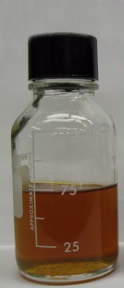FOR IMMEDIATE RELEASE | December 10, 2008
Waste coffee grounds offer new source of biodiesel fuel
Researchers in Nevada are reporting that waste coffee grounds can provide a cheap, abundant, and environmentally friendly source of biodiesel fuel for powering cars and trucks. Their study has been published online in the American Chemical Society’s (ACS) Journal of Agricultural and Food Chemistry, a bi-weekly publication.
In the new study, Mano Misra, Susanta Mohapatra, and Narasimharao Kondamudi note that the major barrier to wider use of biodiesel fuel is lack of a low-cost, high quality source, or feedstock, for producing that new energy source. Spent coffee grounds contain between 11 and 20 percent oil by weight. That’s about as much as traditional biodiesel feedstocks such as rapeseed, palm, and soybean oil.
Growers produce more than 16 billion pounds of coffee around the world each year. The used or “spent” grounds remaining from production of espresso, cappuccino, and plain old-fashioned cups of java, often wind up in the trash or find use as soil conditioner. The scientists estimated, however, that spent coffee grounds can potentially add 340 million gallons of biodiesel to the world’s fuel supply.
To verify it, the scientists collected spent coffee grounds from a multinational coffeehouse chain and separated the oil. They then used an inexpensive process to convert 100 percent of the oil into biodiesel.
The resulting coffee-based fuel — which actually smells like java — had a major advantage in being more stable than traditional biodiesel due to coffee's high antioxidant content, the researchers say. Solids left over from the conversion can be converted to ethanol or used as compost, the report notes. The scientists estimate that the process could make a profit of more than $8 million a year in the U.S. alone. They plan to develop a small pilot plant to produce and test the experimental fuel within the next six to eight months.
Biodiesel is a growing market. Estimates suggest that annual global production of biodiesel will hit the 3 billion gallon mark by 2010. The fuel can be made from soybean oil, palm oil, peanut oil, and other vegetable oils; animal fat; and even cooking oil recycled from restaurant French fry makers. Biodiesel also can be added to regular diesel fuel. It also can be a stand-alone fuel, used by itself as an alternative fuel for diesel engines.
- Mark T.Sampson
*The research in this press release is from a copyrighted publication, and stories must credit the journal by name or the American Chemical Society.
News media may obtain a full text of this report (“Spent Coffee Grounds as a Versatile Source of Green Energy”) in ACS’ Journal of Agricultural and Food Chemistry by contacting Michael Bernstein.
Contact:
Mano Misra, Ph.D.
Professor
Director, Center of Materials Reliability
University of Nevada-Reno
Reno, Nevada 89557-0042
Phone: 775-784-1603
Fax: 775-784-4949
E-mail: misra@unr.edu
###


